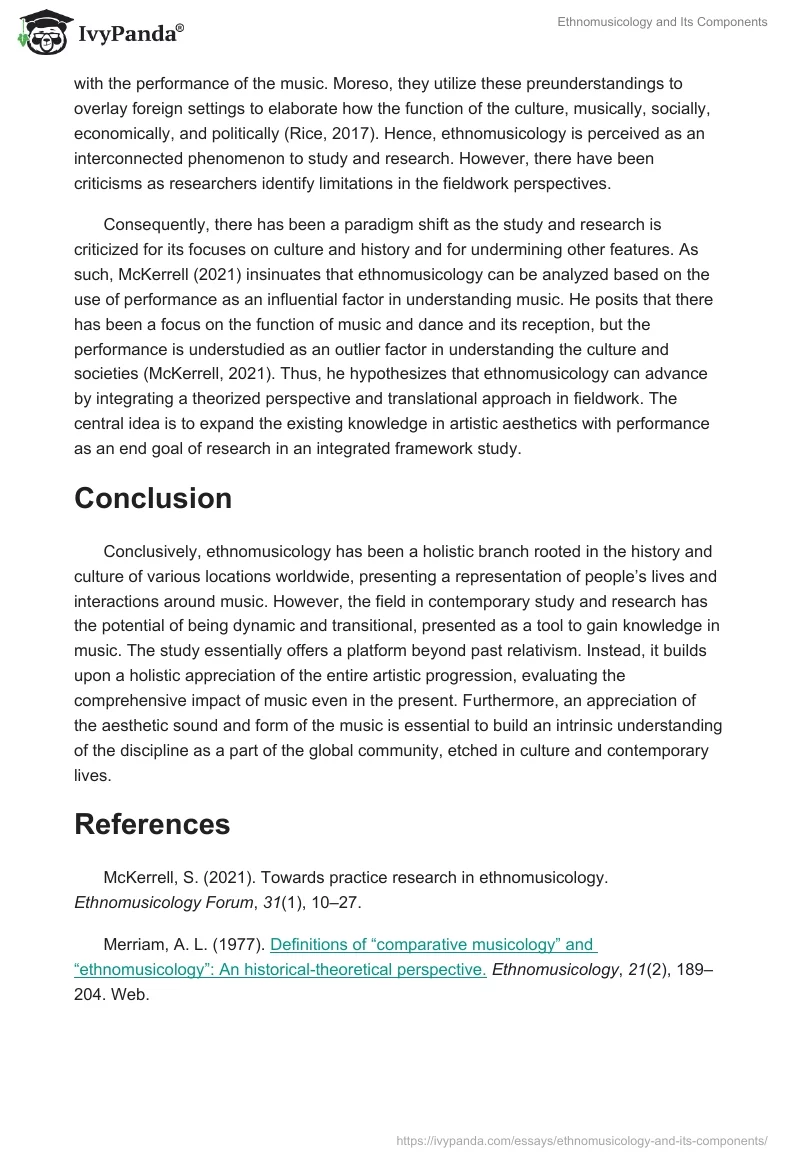Introduction
Music is a predominant phenomenon traced in history as a significant feature of community identity. Consequently, ethnomusicology was incepted as a branch of study focusing on the social-cultural functions and history of musical performance (McKerrell, 2021). Morgenstern (2018) claimed that the branch of the study had been used as a tool to understand expressive cultures considering folklore research and comparative musicology. Hence, ethnomusicology was defined as “the study of the world’s music from a comparative and relativistic perspective” and as an interlinked study of social-anthropologic perspectives of music (Morgenstern, 2018, p.3). Therefore, the study is an essential feature of understanding music based on who made it, when, and where, demonstrative of the differences in sociocultural ideas and concepts. In some ways, it creates an identity linked to cultures, communities, and locations.
Discussion
In addition, at the core of ethnomusicology is an integrated analysis considering all elements that make up the field of music. Merriam (1977) accentuated that understanding musicology was through an accumulation of features, including human behavior influenced by music, the conceptualization of music, and the sound in music separate from its context. The elements give a basis for understanding ethnomusicology fieldwork and its history. To express its approach in fieldwork, Tindon et al. (2001) argued that the process of ethnomusicology entails personal feedback from experiencing music in the world. Rather than reading and researching music, fieldwork requires “witnessing, observing, questioning, tape recording, photographing and performing” as procedures that inform ethnomusicologists’ practice (Tindon et al., 2001, p.457). The appreciation of history combined with a progressive analysis of change was crucial to establish consistent growth and expansion of the discipline.
These definitions and perspectives inform the fieldwork approach taken by ethnomusicologists. Rice (2017) indicated that researchers were supplied initially with a local context of culture and a preunderstanding of music and human values associated with the performance of the music. Moreso, they utilize these preunderstandings to overlay foreign settings to elaborate how the function of the culture, musically, socially, economically, and politically (Rice, 2017). Hence, ethnomusicology is perceived as an interconnected phenomenon to study and research. However, there have been criticisms as researchers identify limitations in the fieldwork perspectives.
Consequently, there has been a paradigm shift as the study and research is criticized for its focuses on culture and history and for undermining other features. As such, McKerrell (2021) insinuates that ethnomusicology can be analyzed based on the use of performance as an influential factor in understanding music. He posits that there has been a focus on the function of music and dance and its reception, but the performance is understudied as an outlier factor in understanding the culture and societies (McKerrell, 2021). Thus, he hypothesizes that ethnomusicology can advance by integrating a theorized perspective and translational approach in fieldwork. The central idea is to expand the existing knowledge in artistic aesthetics with performance as an end goal of research in an integrated framework study.
Conclusion
Conclusively, ethnomusicology has been a holistic branch rooted in the history and culture of various locations worldwide, presenting a representation of people’s lives and interactions around music. However, the field in contemporary study and research has the potential of being dynamic and transitional, presented as a tool to gain knowledge in music. The study essentially offers a platform beyond past relativism. Instead, it builds upon a holistic appreciation of the entire artistic progression, evaluating the comprehensive impact of music even in the present. Furthermore, an appreciation of the aesthetic sound and form of the music is essential to build an intrinsic understanding of the discipline as a part of the global community, etched in culture and contemporary lives.
References
McKerrell, S. (2021). Towards practice research in ethnomusicology. Ethnomusicology Forum, 31(1), 10–27.
Merriam, A. L. (1977). Definitions of “comparative musicology” and “ethnomusicology”: An historical-theoretical perspective.Ethnomusicology, 21(2), 189–204. Web.
Morgenstern, U. (2018). Towards the history of ideas in ethnomusicology. Theory and methods between the late 18th and the early 20th Century. Musicologist, 2(1), 1–31.
Rice, T. (2017). Modeling ethnomusicology. Oxford University Press.
Tindon, J. T., Reck, D. B., & Slobin, M. (2001). Discovering and documenting a world of music. In Worlds of Music: An Introduction to the Music of the World’s Peoples (4th ed.). Schirmer.


